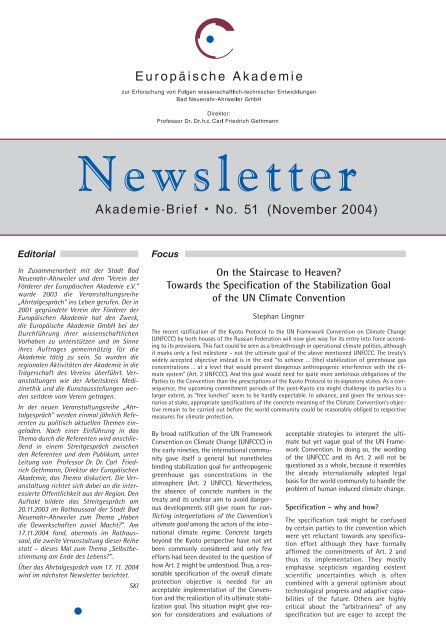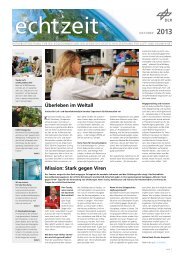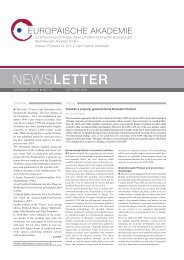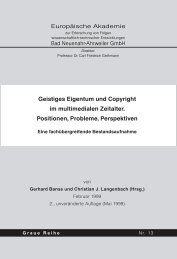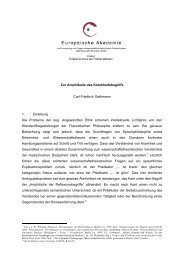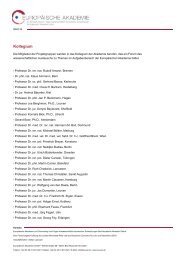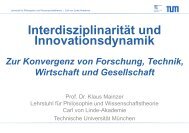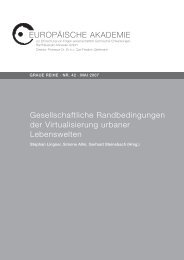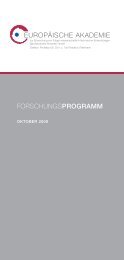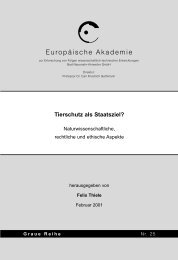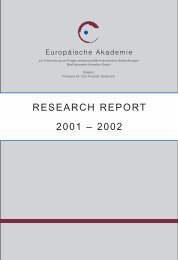Download - Europäische Akademie Bad Neuenahr-Ahrweiler
Download - Europäische Akademie Bad Neuenahr-Ahrweiler
Download - Europäische Akademie Bad Neuenahr-Ahrweiler
You also want an ePaper? Increase the reach of your titles
YUMPU automatically turns print PDFs into web optimized ePapers that Google loves.
Editorial<br />
In Zusammenarbeit mit der Stadt <strong>Bad</strong><br />
<strong>Neuenahr</strong>-<strong>Ahrweiler</strong> und dem "Verein der<br />
Förderer der <strong>Europäische</strong>n <strong>Akademie</strong> e.V."<br />
wurde 2003 die Veranstaltungsreihe<br />
„Ahrtalgespräch" ins Leben gerufen. Der in<br />
2001 gegründete Verein der Förderer der<br />
<strong>Europäische</strong>n <strong>Akademie</strong> hat den Zweck,<br />
die <strong>Europäische</strong> <strong>Akademie</strong> GmbH bei der<br />
Durchführung ihrer wissenschaftlichen<br />
Vorhaben zu unterstützen und im Sinne<br />
ihres Auftrages gemeinnützig für die<br />
<strong>Akademie</strong> tätig zu sein. So wurden die<br />
regionalen Aktivitäten der <strong>Akademie</strong> in die<br />
Trägerschaft des Vereins überführt. Veranstaltungen<br />
wie der Arbeitskreis Medizinethik<br />
und die Kunstausstellungen werden<br />
seitdem vom Verein getragen.<br />
In der neuen Veranstaltungsreihe „Ahrtalgespräch"<br />
werden einmal jährlich Referenten<br />
zu politisch aktuellen Themen eingeladen.<br />
Nach einer Einführung in das<br />
Thema durch die Referenten wird anschließend<br />
in einem Streitgespräch zwischen<br />
den Referenten und dem Publikum, unter<br />
Leitung von Professor Dr. Dr. Carl Friedrich<br />
Gethmann, Direktor der <strong>Europäische</strong>n<br />
<strong>Akademie</strong>, das Thema diskutiert. Die Veranstaltung<br />
richtet sich dabei an die interessierte<br />
Öffentlichkeit aus der Region. Den<br />
Auftakt bildete das Streitgespräch am<br />
20.11.2003 im Rathaussaal der Stadt <strong>Bad</strong><br />
<strong>Neuenahr</strong>-<strong>Ahrweiler</strong> zum Thema „Haben<br />
die Gewerkschaften zuviel Macht?". Am<br />
17.11.2004 fand, abermals im Rathaussaal,<br />
die zweite Veranstaltung dieser Reihe<br />
statt – dieses Mal zum Thema „Selbstbestimmung<br />
am Ende des Lebens?".<br />
Über das Ahrtalgespräch vom 17. 11. 2004<br />
wird im nächsten Newsletter berichtet.<br />
SKI<br />
●<br />
Focus<br />
By broad ratification of the UN Framework<br />
Convention on Climate Change (UNFCCC) in<br />
the early nineties, the international community<br />
gave itself a general but nonetheless<br />
binding stabilization goal for anthropogenic<br />
greenhouse gas concentrations in the<br />
atmosphere (Art. 2 UNFCC). Nevertheless,<br />
the absence of concrete numbers in the<br />
treaty and its unclear aim to avoid dangerous<br />
developments still give room for conflicting<br />
interpretations of the Convention’s<br />
ultimate goal among the actors of the international<br />
climate regime. Concrete targets<br />
beyond the Kyoto perspective have not yet<br />
been commonly considered and only few<br />
efforts had been devoted to the question of<br />
how Art. 2 might be understood. Thus, a reasonable<br />
specification of the overall climate<br />
protection objective is needed for an<br />
acceptable implementation of the Convention<br />
and the realization of its ultimate stabilization<br />
goal. This situation might give reason<br />
for considerations and evaluations of<br />
51 (November 2004)<br />
On the Staircase to Heaven?<br />
Towards the Specification of the Stabilization Goal<br />
of the UN Climate Convention<br />
Stephan Lingner<br />
The recent ratification of the Kyoto Protocol to the UN Framework Convention on Climate Change<br />
(UNFCCC) by both houses of the Russian Federation will now give way for its entry into force according<br />
to its provisions. This fact could be seen as a breakthrough in operational climate politics, although<br />
it marks only a first milestone – not the ultimate goal of the above mentioned UNFCCC. The treaty’s<br />
widely accepted objective instead is in the end “to achieve … (the) stabilization of greenhouse gas<br />
concentrations … at a level that would prevent dangerous anthropogenic interference with the climate<br />
system” (Art. 2 UNFCCC). And this goal would need for quite more ambitious obligations of the<br />
Parties to the Convention than the prescriptions of the Kyoto Protocol to its signatory states. As a consequence,<br />
the upcoming commitment periods of the post-Kyoto era might challenge its parties to a<br />
larger extent, as “free lunches” seem to be hardly expectable. In advance, and given the serious scenarios<br />
at stake, appropriate specifications of the concrete meaning of the Climate Convention’s objective<br />
remain to be carried out before the world community could be reasonably obliged to respective<br />
measures for climate protection.<br />
acceptable strategies to interpret the ultimate<br />
but yet vague goal of the UN Framework<br />
Convention. In doing so, the wording<br />
of the UNFCCC and its Art. 2 will not be<br />
questioned as a whole, because it resembles<br />
the already internationally adopted legal<br />
basis for the world community to handle the<br />
problem of human induced climate change.<br />
Specification – why and how?<br />
The specification task might be confused<br />
by certain parties to the convention which<br />
were yet reluctant towards any specification<br />
effort although they have formally<br />
affirmed the commitments of Art. 2 and<br />
thus its implementation. They mostly<br />
emphasise scepticism regarding existent<br />
scientific uncertainties which is often<br />
combined with a general optimism about<br />
technological progress and adaptive capabilities<br />
of the future. Others are highly<br />
critical about the “arbitrariness” of any<br />
specification but are eager to accept the
2 Newsletter No. 51 <strong>Europäische</strong> <strong>Akademie</strong> <strong>Bad</strong> <strong>Neuenahr</strong>-<strong>Ahrweiler</strong><br />
arbitrary outcomes of a “muddling<br />
through” in climate politics. Therefore,<br />
sceptical conclusions on specification cannot<br />
be reasonably supported as both argumentations<br />
seem inconsistent. Moreover, it<br />
has to be recalled that appropriate specifications<br />
are a must, as they are constitutive<br />
for any political objective and thus for the<br />
stabilization goal of the treaty, too. Otherwise,<br />
there would remain only the broad<br />
but vague aim to control emissions without<br />
binding obligations for any Party<br />
which would probably result in businessas-usual.<br />
Calls for specification in decisive<br />
terms concerning emission quantities,<br />
allowed time-frames and the specific obligations<br />
of the respective actors concerned<br />
are therefore implicitly embedded in Art. 2<br />
UNFCCC as a political aim and common<br />
interest of its Parties. This interest is<br />
expressed by their membership to the Convention.<br />
Claims of any Party not to specify<br />
the treaty should be therefore rejected.<br />
Furthermore, even how to specify is prescribed<br />
by binding claims of the internationally<br />
adopted legal rules of the Vienna<br />
Convention of the Treaties in a way that<br />
international conventions like the UNFCCC<br />
have to be interpreted “in good faith and<br />
with regard to their original purpose”. Consequently,<br />
any strategic or particularistic<br />
reasoning in this sense should be rejected<br />
as not acceptable.<br />
Challenging constraints<br />
The treaty’s stabilization goal to avoid<br />
dangerous levels is augmented by the constraints<br />
to allow for ecosystems adaptation,<br />
to ensure food production and to<br />
enable sustainable economic development.<br />
A specific problem of the specification<br />
task is given by the strong interrelationships<br />
between these constraints which<br />
may lead to complex and sometimes conflicting<br />
trade-offs especially between the<br />
ecological and economical aims of the<br />
treaty. Moreover, each of the three constraints<br />
can be interpreted and assessed<br />
quite differently with respect to their relevant<br />
spatial and inter-temporal scales,<br />
their specific uncertainties, as well as the<br />
distributional consequences associated<br />
with impacts from climate change and climate<br />
politics. Therefore, policy-makers<br />
may have to impose reasonable restrictions<br />
on any of these trade-offs between the<br />
three constraints as well as on the mentioned<br />
four dimensions of the three constraints<br />
in order to find operational ways<br />
to deal with questions as to which scale of<br />
regional and temporal disruptions are<br />
acceptable or how to bridge the distributional<br />
implications of unequal climate<br />
impacts or policies. This may, for example,<br />
become evident concerning the question if<br />
local, regional or global food production<br />
would have to be secured and consequently,<br />
on which spatial level respective compensations<br />
by trading foodstuffs would be<br />
necessary.<br />
The ethical perspective<br />
The aim to avoid “dangerous interference<br />
with the climate system” as well as its<br />
framing constraints cannot be described<br />
by science only. Instead, all claims of Art. 2<br />
are clearly related to normative questions.<br />
Thus, due to the absence of concrete legal<br />
measures, any reasonable interpretation of<br />
Art. 2 has to undergo ethical weighing.<br />
Some sceptics may point out that there<br />
might be severe divides among the ultimate<br />
principles of ethics which may<br />
obstruct any normative orientation.<br />
Nevertheless, some reasonable practical<br />
convergence may be expected on the level<br />
of applied ethics, thus avoiding confusion<br />
from theoretical differences.<br />
Indeed, given some modest premises about<br />
inter-temporal obligations and precaution,<br />
almost all ethical theories and approaches<br />
seem to converge towards a consensus with<br />
regard to the ultimate objective of the climate<br />
convention. Moreover, as the wording<br />
of Art. 2 lacks any requests for utility maximising,<br />
its ultimate goal might be mainly<br />
interpreted along deontological claims<br />
against victimization or injury for the present<br />
and the future, thus resulting primarily<br />
in recommendations for safety-oriented<br />
measures. Corresponding claims, like avoiding<br />
false-positive outcomes and/or largescale<br />
damages, may argue in favour of relatively<br />
low stabilization levels. Additional<br />
statements can be concluded from reasonable<br />
obligations towards future generations:<br />
Given the acceptability of comparative standards,<br />
members of future generations would<br />
have strong moral “claims” to living conditions,<br />
which should not be worse than those<br />
of our contemporaries. If this was to be<br />
combined with the precautionary principle,<br />
only relatively low stabilization levels could<br />
be justified. Nevertheless, somewhat higher<br />
stabilization levels might be tolerable if<br />
absolute standards like basic-needs considerations<br />
would have met with some reasonable<br />
optimism about adaptive capabilities of<br />
the future to a changing climate.<br />
Different approaches in environmental<br />
ethics provide a variety of arguments as to<br />
how strict the above mentioned constraints<br />
should be interpreted: For instance, the<br />
ecosystems adaptability-constraint cannot<br />
be restricted to global cycles if reasonable<br />
obligations in favour of sentient creatures<br />
and their habitats should have to be considered.<br />
Therefore, the need to protect these<br />
habitats on regional or even local scales is<br />
also to be seen as an argument in favour of<br />
low stabilization levels. Food production and<br />
its availability, on the other hand, is only<br />
partly a function of climate change. Therefore,<br />
low stabilization levels can only be<br />
claimed by adequate co-evaluation of all<br />
social, economical and cultural drivers of<br />
potential food shortages. There are various<br />
interpretations of the sustainable economicdevelopment-constraint<br />
of Art. 2 according<br />
to different theoretical approaches towards<br />
the meaning of “sustainability”. Correspond-<br />
ing evaluations of natural systems relative to<br />
the production of goods and services would<br />
therefore lead to quite different results. The<br />
corresponding outcome is especially relevant<br />
for balancing the needs for ecosystems<br />
adaptation and economic development.<br />
However, a coherent and ethically sound<br />
interpretation of Art. 2 which parallels food<br />
availability, habitat protection and low<br />
greenhouse gas levels can be outlined. The<br />
crucial problem remains to give the “sustainable<br />
economic-development”-constraint<br />
a reasonable interpretation which fits into<br />
this picture. It could be weakened if the<br />
ecosystems and food constraints were interpreted<br />
more ambitiously.<br />
Concluding from the ethical convergence<br />
thesis on low stabilization levels, certain<br />
prescriptions in favour of possible emission<br />
paths can be justified if a set of relevant<br />
criteria, principles and priority rules were<br />
considered, too. Applied to the conceivable<br />
energy scenarios published by the socalled<br />
“Special Report on Emission Scenarios”<br />
(SRES) one might favour those developments<br />
towards global decarbonisation,<br />
sustainability and equity improvement –<br />
resembled by the SRES-scenario B1.<br />
Political feasibility?<br />
The interpretation und specification of the<br />
ultimate objective of the UNFCCC will<br />
probably become a key issue in climate<br />
negotiations beyond the upcoming<br />
enforcement of the Kyoto Protocol. The<br />
recent positioning of political actors on<br />
Art. 2, on concrete greenhouse gas emissions<br />
and targeted concentrations may<br />
already shape the current negotiation<br />
process. This could contribute to an early<br />
clustering of key players into potential<br />
coalitions. Those who are willing to push<br />
the agenda towards the stabilization goal<br />
– such as the member states of the European<br />
Union – are currently facing strong<br />
resistance by the USA or a few of the<br />
developing and transitional countries<br />
(G77) who want to postpone or even<br />
refuse any commitments. Countries of a<br />
third, more intermediate group – like Russia<br />
or the other members of the G77 –<br />
could tip the scales in setting the future<br />
agenda in one or the other direction.<br />
However, the heterogeneity of the G77<br />
induces also potential conflicts within this<br />
undecided group that may contribute to<br />
slowing further progress on achieving the<br />
ultimate objective. Nevertheless, the need<br />
for accelerating the process may prevail<br />
with increasing attention of developing<br />
countries to their own vulnerability to<br />
impacts from climate change. A unifying<br />
crucial element within the G77-countries<br />
seems to emerge with respect to the fair<br />
access of all Parties to the atmosphere as<br />
a common global good for the deposition<br />
of greenhouse gases. Therefore, equity<br />
questions might become cross-cutting<br />
issues in the upcoming negotiations,<br />
enabling the formation of coalitions
<strong>Europäische</strong> <strong>Akademie</strong> <strong>Bad</strong> <strong>Neuenahr</strong>-<strong>Ahrweiler</strong> Newsletter No. 51 3<br />
between the EU, the G77 and China among<br />
possibly others. If the European Union succeeded<br />
in strengthening the equity issue on<br />
the next agendas in combination with its<br />
relatively ambitious goals for climate protection<br />
it might initiate the aforementioned<br />
coalition building which again<br />
might question or even alter the currently<br />
different position of the USA upon the climate<br />
problem. This could – in the end –<br />
contribute to the solution of the recent<br />
transatlantic differences on this issue.<br />
Irrespective of any strategic considerations,<br />
it would be desirable to allow for fair<br />
negotiations. Transparency, consistency,<br />
and universal validity of any argumentation<br />
put forward towards specification of<br />
Art. 2 may support its acceptability and<br />
preferably its factual long-term acceptance.<br />
Whether pursuing the long-term<br />
aspirations of Art. 2 is compatible with the<br />
often shorter-term negotiation horizon<br />
remains – however – an open question.<br />
This contribution summarizes some central concerns<br />
of the recently released academy’s study<br />
“Reasoning Goals of Climate Protection. Specification<br />
of Art. 2 UNFCCC” which was conducted<br />
on behalf of the Federal Environmental Agency<br />
of Germany (UBA). This topic will be also discussed<br />
early December 2004 on the occasion of<br />
a side-event to the 10th Conference of the Parties<br />
to the UNFCCC in Buenos Aires. The complete<br />
study may be downloaded from the academy’s<br />
homepage (www.europaeische-akademieaw.de),<br />
both in English and German language.<br />
Dr. Stephan Lingner is member of the scientific<br />
staff of the <strong>Europäische</strong> <strong>Akademie</strong>. He coordinated<br />
diverse projects on the rational treatment<br />
of climate and other environmental problems.<br />
●<br />
Working Groups<br />
Nanomaterials, Nanodevices, Nanocomputing.<br />
Standortbestimmung und Perspektiven.<br />
The project group held a meeting in<br />
Puidoux/Lausanne (Switzerland) from 22<br />
to 24 September. There, modalities and<br />
details of the upcoming Mid-term Meeting<br />
wered planned and prepared. The Midterm<br />
Meeting itself took place in <strong>Bad</strong><br />
<strong>Neuenahr</strong>-<strong>Ahrweiler</strong> on 8 October, framed<br />
by another project group session from 7 to<br />
9 October.<br />
At the Mid-term Meeting, preliminary<br />
study results were presented to a total of<br />
11 peer reviewers that had previously been<br />
sent the report and asked to judge its quality.<br />
The referees were Dr. Gerd Bachmann<br />
(VDI-Technologiezentrum Düsseldorf), Professor<br />
Dr. Peter Bäuerle (Abteilung Organische<br />
Chemie II, Universität Ulm), Professor<br />
Dr. Paul Borm (CEL Technohouse,<br />
Hogeschool Zuyd, The Netherlands), Professor<br />
Dr. Harald Fuchs (Fachbereich<br />
Physik, Universität Münster), Professor Dr.<br />
Uwe Hartmann (FR 10.2-Experimentalphysik,<br />
Universität des Saarlandes, Saarbrücken),<br />
Professor Dr. Christoph Hubig<br />
(Institut für Philosophie, Universität<br />
Stuttgart), Professor Dr. Martin Möhrle<br />
(Lehrstuhl für Betriebswirtschaftslehre,<br />
Universität Bremen), Professor Dr. Reinhard<br />
Nesper (Laboratorium für Anorganische<br />
Chemie, ETH Zürich, Switzerland), Professor<br />
Dr. Andreas Offenhäusser (Institut für<br />
Schichten und Grenzflächen, Forschungszentrum<br />
Jülich), Dr. Markus Pridöhl<br />
(Degussa AG, Hanau) and Dr. Eberhard<br />
Seitz (Projektträger Jülich, Forschungszentrum<br />
Jülich, formerly with the Research<br />
Directorate Generale, European Commission,<br />
Brussels). They agreed with the<br />
report’s basic structure and approved the<br />
interdisciplinary point of view taken by the<br />
group. In addition, they commented on the<br />
project group’s definition proposal of the<br />
term “Nanotechnology” and stated possible<br />
concerns about its simplicity, its specific<br />
purpose and its consistency with the rest<br />
of the study.<br />
All of the suggestions were thoroughly discussed<br />
by the project group afterwards.<br />
The project group will now consider to<br />
broaden the definition, accounting for the<br />
fact that Nanotechnology’s roots can lie in<br />
Nanoscience as well as in Nanoengineering,<br />
or in both. The results of the internal<br />
evaluation of the referees’ views will now<br />
be incorporated into the study, leading to<br />
altered text contributions and to a higher<br />
degree of coherency.<br />
Project Coordinator:<br />
Dipl.-Ing. Wolfgang Rathgeber<br />
Phone +49 (0) 26 41 - 973 308<br />
wolfgang.rathgeber@dlr.de<br />
Environmental Noise<br />
The project group invited Dr. Henk Miedema<br />
(TNO Delft) to discuss a paper on its recent<br />
progress meeting on 13 September 2004.<br />
The paper on “Annoyance caused by environmental<br />
noise” focused on empirical<br />
based relationships between annoyance and<br />
exposure as well as on the role of other factors,<br />
like source-specific fears or individual<br />
noise sensitivities. Therefore, annoyance<br />
from aircraft noise might result in higher<br />
levels than those from car traffic, even if<br />
the physical loads were in the same order.<br />
Concerning the problem to estimate noise<br />
annoyance in the practise (prospective noise<br />
mapping) Dr. Miedema highlighted the<br />
necessity to model the effects of environmental<br />
noise from multiple sources. He recommends<br />
to calculate cumulative noise<br />
annoyances by an annoyance equivalents<br />
model, which predicts elevated but nonadditive<br />
sum-effects of mixed noise loads.<br />
The results of Dr. Miedema’s expertise will<br />
be integrated into the respective sections of<br />
the future study report. Moreover, the<br />
members of the project group discussed<br />
numerous internal papers on: historical<br />
reflections of noise acceptance, noiseinduced<br />
communication disturbances, calculation<br />
of emissions from traffic noise,<br />
principles of standard setting and on<br />
respective weighing problems on levels of<br />
the German legislative and executive.<br />
Project Coordinator: Dr. Stephan Lingner<br />
Phone +49 (0) 26 41 - 973 306<br />
stephan.lingner@dlr.de<br />
News<br />
●<br />
Expert Groups<br />
Professor Dr. Dr. C.F. Gethmann was member<br />
of the accreditation commission of the<br />
accreditation institute ACQUIN for the BAstudy<br />
course ”philosophy and economics“<br />
at the Universität Bayreuth. The solemnisation<br />
took place in Bayreuth on 9 July 2004.<br />
Furthermore, Professor Gethmann was<br />
member of the expert group ”Jugenddiskurs<br />
Bioethik“ of the Federal Ministry of<br />
Education and Research (Bundesministerium<br />
für Bildung und Forschung, BMBF).<br />
Technology Forum “Mit Lebensmitteln<br />
heilen? – Wachstumsmarkt Functional<br />
Foods”<br />
The <strong>Europäische</strong> <strong>Akademie</strong> presented its<br />
study “Functional Foods” at the technology<br />
forum “Mit Lebensmitteln heilen? – Wachstumsmarkt<br />
Functional Foods” at the Chamber<br />
of Commerce and Industry in Potsdam<br />
on 27 October 2004. Professor Dr. Gerhard<br />
Rechkemmer, who was member of the<br />
academy´s project group “Functional Foods”<br />
and holds a chair for “Biofunktionalität der<br />
Lebensmittel” at the Technische Universität<br />
München, presented in his speech the study<br />
and reported about its results. The study on<br />
“Functional Foods” has been published in<br />
April 2004 and examines the public perception<br />
of functional foods as well as legal/<br />
political, economic and ethical questions<br />
and provides recommendations for public<br />
action. Further information about the study<br />
can be found on the academy´s web site<br />
www.europaeische-akademie-aw.de.<br />
120 representatives from the policy-making<br />
community, research and industry participated<br />
in the conference which aim was<br />
to provide an overview about the recent<br />
developments in the food sector and to<br />
discuss the different processes, chances<br />
and limits of functional foods with specific<br />
focus on the regional potential of Brandenburg.<br />
The technology forum has been<br />
organised by the “Verein zur Förderung der<br />
Nutrigenomforschung e.V.“ and the “Landesarbeitsgemeinschaft<br />
der Industrie- und<br />
Handelskammern des Landes Brandenburg”.
4 Newsletter No. 51 <strong>Europäische</strong> <strong>Akademie</strong> <strong>Bad</strong> <strong>Neuenahr</strong>-<strong>Ahrweiler</strong><br />
Art<br />
Von Oktober 2004 bis März 2005 sind die<br />
Bilder der Künstlerin Margarete Gebauer in<br />
den Räumen der <strong>Europäische</strong>n <strong>Akademie</strong><br />
ausgestellt. Aktueller Mittelpunkt des<br />
Schaffens von Margarete Gebauer sind<br />
Darstellungen des nackten, weiblichen<br />
Körpers. Die Werke der Künstlerin können<br />
täglich zwischen 9.00 und 16.00 Uhr<br />
besichtigt werden.<br />
Book Series<br />
●<br />
The 24 th volume of the <strong>Europäische</strong><br />
Äkademie’s book series “Wissenschaftsethik<br />
und Technikfolgenbeurteilung” was<br />
published recently:<br />
F. Thiele, R. Ashcroft: Bioethics in a Small<br />
World. Springer-Verlag Berlin 2004, ISBN<br />
3-540-23595-7<br />
Lectures<br />
●<br />
Carl Friedrich Gethmann<br />
4.11.04 „Darf der Mensch alles was er<br />
kann?“ Podiumsdiskussion Stadthalle<br />
Westerberg, Westerwald<br />
8.11.04 „Wissenschaftlicher Forschergeist<br />
und gesellschaftliche Verantwortung –<br />
Max von Laue zum 125. Geburtstag“. Podiumsdiskussion,<br />
Landesvertretung Rheinland-Pfalz,<br />
Berlin<br />
10.11.04 „Warum sollen wir überhaupt<br />
etwas und nicht vielmehr nichts?“, Institut<br />
für Philosophie der Universität Leipzig<br />
24.11.04 „Neuer schöner Mensch?<br />
Möglichkeiten und Grenzen der Menschengestaltung<br />
durch Gentechnik und<br />
künstliche Intelligenz“. Podiumsdiskussion<br />
zur Eröffnung der Konferenz „Technik in<br />
einer fragilen Welt“, Berlin<br />
29.11.04 „Was heißt universitäre Bildung?“<br />
Podiumsdiskussion Friedrich Naumann-<br />
Stiftung, Mainz<br />
Felix Thiele<br />
14.10.04 “Predictive medicine and practice<br />
in clinical medicine – the case of genetic<br />
testing.” Annual meeting of the European<br />
association of centres of medical ethics.<br />
14.–16. October 2004. Institut Catholique<br />
de Lille, Centre d’Ethique Médicale, Lille<br />
8.11.04 „Bioethis. Theory & Application.“<br />
Vortrag im Rahmen der Einführungswoche<br />
für die neuen Ph.D. Studenten am European<br />
Molecular Biology Laboratory, Heidelberg<br />
11.11.04 “Is there a difference between<br />
genetic data and conventional medical<br />
data?” Fachgespräch Genetic data and<br />
biobanks. Data protection, patient rights<br />
and research needs. <strong>Europäische</strong> <strong>Akademie</strong><br />
für Informationsfreiheit und Datenschutz.<br />
11.–12. November, Berlin<br />
12.11.04 „Moralische Probleme der<br />
Stammzellforschung.“ 5th Annual Meeting<br />
of the DFG-Priority Program 1109 ‘Embryonic<br />
and Tissue-Specific Stem Cells –<br />
Regenerative Systems for Cell and Tissue<br />
Repair’. 11.–13. November, Potsdam<br />
●<br />
Publications<br />
Carl Friedrich Gethmann<br />
„Rechtfertigungsdiskurse“, in: H. Friesen/<br />
K. Berr (Hgg) Angewandte Ethik im Spannungsfeld<br />
von Begründung und Anwendung,<br />
Frankfurt a. M. 2004, 111–158 (mit<br />
T. Sander)<br />
“The Special Status of the Human Being as<br />
a Topic of Practical Philosophy”, in: H.-R.<br />
Duncker/K. Prieß (Eds.) On the Uniqueness<br />
of Mankind, Berlin/Heidelberg 2004,<br />
95–105<br />
Jorge Guerra González<br />
Prevention of the Xenogenic Infection Risk<br />
and the Spanish and German Constitutions,<br />
in: Law an the Human Genome<br />
Review, Fundación BBVA, Rev Der Gen H<br />
20/2004 January-June 2004, 123–146<br />
Stephan Lingner<br />
J. Loomis, G. Helfand: Environmental policy<br />
analysis for decision making (Book<br />
Review), in: Poiesis & Praxis. International<br />
Journal of Technology Assessment and<br />
Ethics of Science, Volume 3, Numbers 1–2,<br />
2004, 148–151<br />
●<br />
Personalities<br />
Günter Schmid studied chemistry at the<br />
Universität München and finished his PhD<br />
in Inorganic Chemistry in 1965. In 1966 he<br />
moved to the Universität Marburg, where<br />
he performed his habilitation which was<br />
completed in 1969. Two years later he got<br />
a professorship at the same university and<br />
from 1975–1976 he was the dean of the<br />
chemical faculty in Marburg. In 1977 he<br />
followed a call to the chair for Inorganic<br />
Chemistry at the Universität Essen, where<br />
he acted as the director of the Institute for<br />
Inorganic Chemistry until his retirement in<br />
2002. Since then he is working as an emeritus.<br />
From 1977 until 2002 Professor<br />
Schmid occupied several academic positions.<br />
From 1987–1988 he was the dean of<br />
the chemical faculty and from 1988–1992<br />
he was a member of the rectorate of the<br />
university, responsible for research.<br />
His scientific interests were and still are<br />
focused on the synthesis, investigation and<br />
application of transition metal nanoparticles,<br />
mainly on the fields of catalysis, medicine<br />
and future storage devices. He published<br />
more than 300 original scientific<br />
papers and edited two books on nanoparticles<br />
and is member of five editorial boards of<br />
international journals. Furthermore, he is<br />
member of the advisory board of the Institute<br />
for Science and Ethics at the Universities<br />
of Bonn and Essen.<br />
In 2003 Professor Schmid received the Wilhelm-Klemm-Award<br />
from the German<br />
Chemical Society for his work on<br />
Nanoscience and Nanotechnology.<br />
Professor Schmid is Chairman of the <strong>Europäische</strong><br />
<strong>Akademie</strong>’s project group “Nanomaterials, Nanodevices,<br />
Nanocomputing. Standortbestimmung<br />
und Perspektiven“.<br />
●<br />
Publisher: <strong>Europäische</strong> <strong>Akademie</strong> zur Erforschung von Folgen wissenschaftlich-technischer Entwicklungen<br />
<strong>Bad</strong> <strong>Neuenahr</strong>-<strong>Ahrweiler</strong> GmbH, Wilhelmstraße 56, D-53474 <strong>Bad</strong> <strong>Neuenahr</strong>-<strong>Ahrweiler</strong><br />
e-mail: europaeische.akademie@dlr.de, Internet: www.europaeische-akademie-aw.de<br />
Director: Professor Dr. phil. Dr. phil. h.c. Carl Friedrich Gethmann (V.i.S.d.P.)<br />
Editing: Sevim Kiliç, Dipl.-Päd., Phone +49 (0) 2641-973 313, Fax 973 320, sevim.kilic@dlr.de<br />
Print: Warlich Druck <strong>Ahrweiler</strong> GmbH, <strong>Bad</strong> <strong>Neuenahr</strong>-<strong>Ahrweiler</strong><br />
ISSN 1432-0150, frequency of publication: 8 – 10 times per year, 2.700 copies, reproduction is permitted<br />
with reference to the source, please send two voucher copies.


